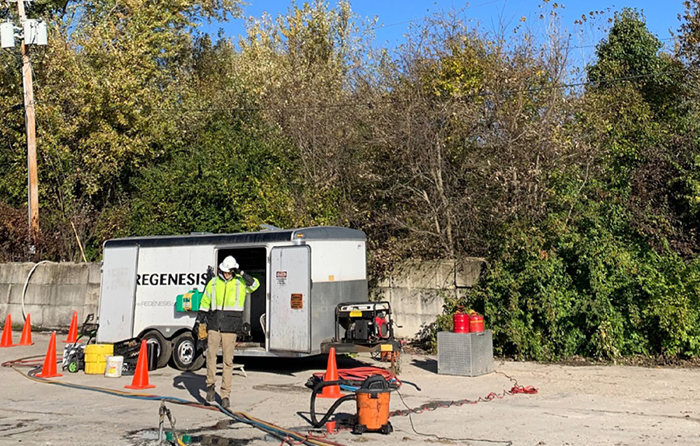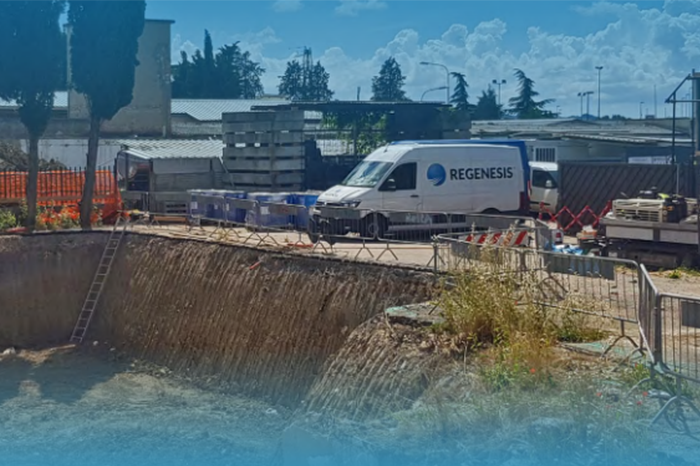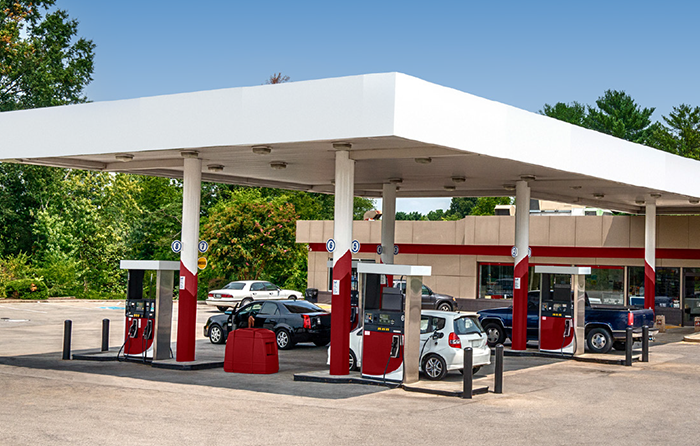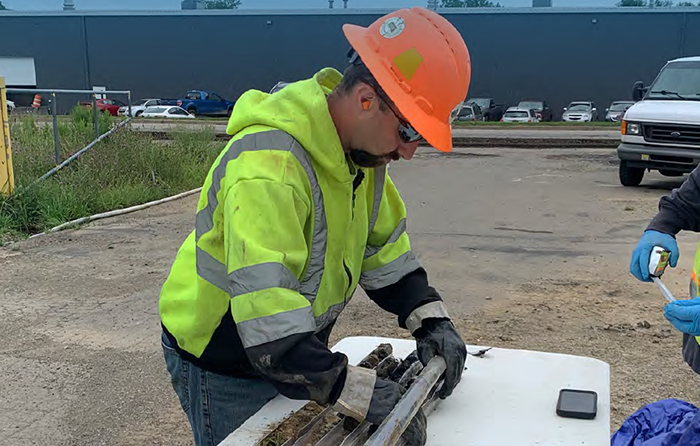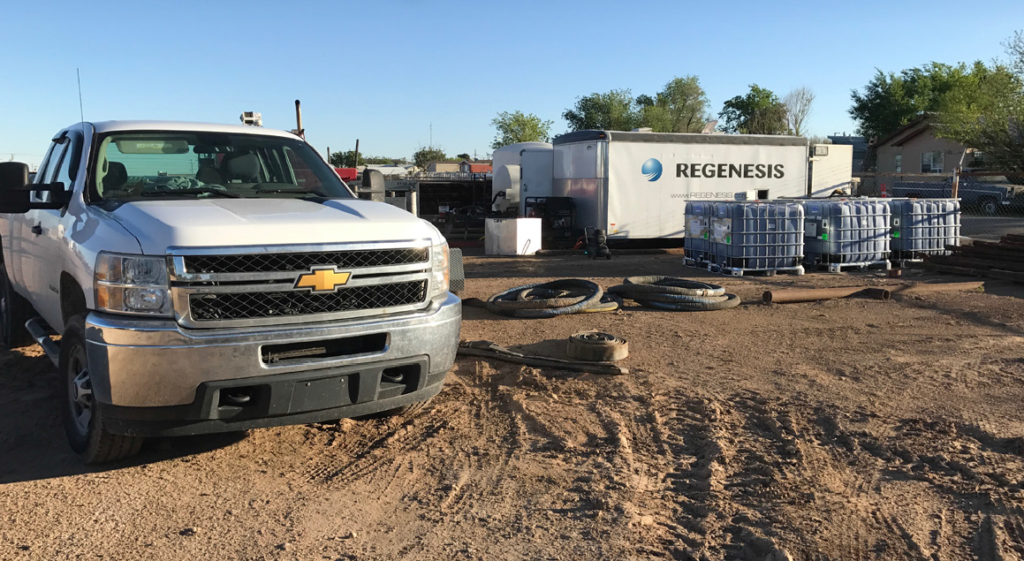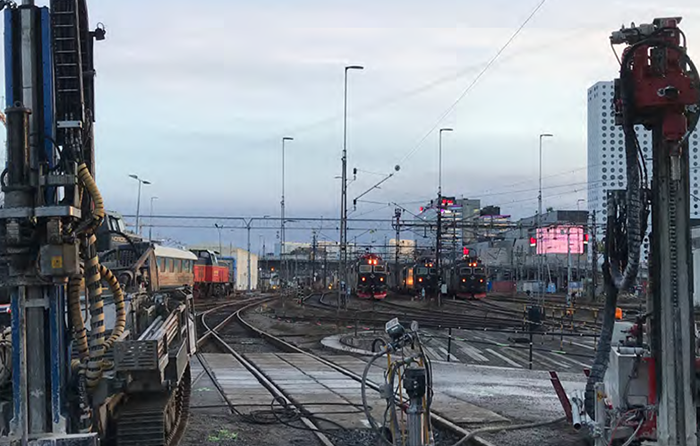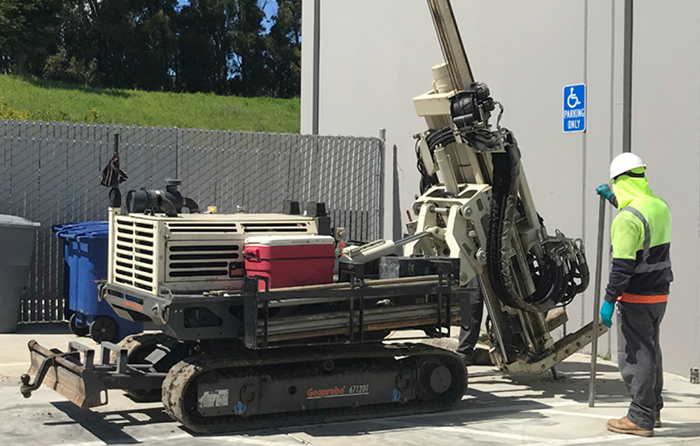Reductive Dechlorination Approach Treats Large Chlorinated Solvent Plume
Case study highlights:
- Innovative combined remedy on active site effectively eliminates risk to adjacent property
- Remedy from REGENESIS chosen based on proven effectiveness in treating similar large CVOC plumes
- Design Verification Testing and placement validation guide a successful remedial application
This case study reviews the successful in-situ treatment of chlorinated solvents at a former food processing plant located in a suburb south of Indianapolis. PlumeStop, S-MicroZVI, 3DME and BDI Plus were used in combination to strongly inhibit CVOC plume migration near the site property boundary while enhancing abiotic and biotic degradation of CVOCs at this location and in the upgradient plume area. Patriot Engineering and Environmental, Inc. (Patriot), a leading consulting firm based in Indianapolis, investigated the site, discovering contaminants had migrated from an unidentified source and formed a large plume. In addition, it was found that the plume was being pulled toward a former (now inactive) public water supply well. The primary chlorinated volatile organic compounds (CVOCs) detected in the plume were tetrachloroethene (PCE), trichloroethene (TCE), and cis-1,2-dichloroethene (cis-DCE).
Injectable PRB Provides Rapid Remediation of Chlorinated Plume Allowing Redevelopment within Months
Case study highlights:
- An in situ permeable reactive barrier (iPRB) was installed combining PlumeStop, S-MicroZVI and BDI Plus reagents
- Additional Design Verification Testing (DVT) was completed by REGENESIS prior to full-scale works
- Remediation targets and the client’s economic requirements were achieved on time and within budget, under a guaranteed contract
Stringent regulatory targets achieved in short timescale, despite challenging site conditions. Historical industrial activities at a former silver frames manufacturing facility in Central Italy had caused chlorinated solvent contamination in the subsurface, which was extending beyond the site boundary. As the site was undergoing redevelopment into residential buildings, the construction company had a strict deadline for remediation to be completed and so a strategy was needed to avoid the long-term installation of active pumping equipment onsite.
Combined ISCR and ERD Remedial Approach Knocks Down PCE Concentrations in Poland
Case study highlights:
- Safe and easy co-injection of PlumeStop and S-MicroZVI
- A grid of 30 injection wells was used, with a 4m spacing between wells
- A rapid, significant drop in PCE concentrations was achieved in the entire treatment area, with no daughter products observed
- Monitoring is ongoing
Rapid groundwater treatment achieved at manufacturing plant, without daughter product build-up. At an active manufacturing plant in the region of Greater Poland, in the West of the country, historical perchloroethylene (PCE) contamination was found to be impacting both soil and groundwater. Environmental company PROTE determined that contamination originated from a number of spills and leakages that occurred over the >20 years of manufacturing on the site.The canal adjacent to the site was identified as a potential downgradient receptor vulnerable to impact from offsite advection of the contamination. Therefore, remediation was driven by a requirement to remove the site owner’s potential liability, whilst being completed within strict budgetary restrictions.
Cleanup Goals Met Post PetroFix Application
Case study highlights:
- Injecting PetroFix was the lowest cost option and fastest route to site closure
- An air sparge/multi-phase extraction (AS/MPE) system provided significant reductions to PHC concentrations, but was unable to meet required cleanup levels
- PetroFix application quickly achieves cleanup goals and sustains reductions for over two years
This case study reviews a former gasoline station located in the Florida Panhandle, where an underground storage tank (UST) release site is now poised for closure. After reviewing the available remedial options, Advanced Environmental Technologies, LLC (AET), a leading environmental consulting and engineering firm, determined PetroFix® Remediation Fluid would provide the most economical and efficient means to reduce concentrations below the groundwater cleanup target levels and achieve site closure. Injection of PetroFix, a field-proven, colloidal activated carbon technology developed for PHC treatment, is a highly targeted and minimally invasive in situ approach, requiring low pressure for injection delivery. Since this was an active business, these features were favored for the minimal impact on operations compared to other approaches.
PlumeStop Successfully Remediates PFAS at Alaska Airport
Case study highlights:
- Targeted PFAS contaminants remediated to below detection limits at airport site
- Challenging environmental conditions overcome for a successful PFAS source zone treatment
- PlumeStop application has completely remediated the five individual PFAS targeted, reducing concentrations from 1,200 ng/L to non-detect
This case study reviews a site where PlumeStop® Colloidal Activated Carbon was applied to treat PFAS resulting from aqueous film-forming foam (AFFF) usage at an airport facility in Alaska. The application has reduced the five targeted PFAS below detection limits and applicable cleanup levels in a challenging hydrogeologic environment over a sampling period now approaching two years. In 2017, Fairbanks International Airport began an investigation in collaboration with the Alaska Department of Environmental Conservation and the Fairbanks office of Shannon & Wilson, a leading Pacific Northwest-based environmental consulting firm, to investigate the extent of PFAS migration from the site. Shannon & Wilson engaged REGENESIS for a pilot test plan to remediate one of the identified AFFF release areas, following successful treatments demonstrated at other sites.
225m Permeable Reactive Barrier Treats TCE and Chromium (VI)
Case study highlights:
- A large-scale remediation project with challenging conditions: geology, underground services, ongoing site use and multiple stakeholders
- Treatment of a co-mingled chromium (VI) and TCE plume via enhanced biological dechlorination and chemical reduction, using: S-MicroZVI,
3-D Microemulsion and BDI Plus - Pilot study proves appropriateness of the proposed in situ remedial solution, allowing regulatory sign off for the full scale works.
- Post remediation monitoring results to date show significant chromium reduction and TCE below detection limits
Sustainable and cost-effective remediation of a co-mingled plume in a sensitive chalk aquifer. A 48 hectare site in the UK was to be redeveloped for mixed commercial and residential use. The existing site included a mix of historic and existing industrial land use, including a metal plating works, surrounded by agricultural land and residential housing. The Mott MacDonald engaged early with REGENESIS regarding potential options for remediation.
New York Brownfield Site Treated for PFAS Achieves Closure
Case study highlights:
- NYSDEC certifies cleanup requirements achieved, making the site eligible for redevelopment
- Brownfield cleanup program’s green remediation policy leads to PlumeStop for PFAS treatment
- PlumeStop barrier for PFAS treatment is a key component in pursuit of site closure
- Skillfully managed PlumeStop application achieves GSR and cost reduction objectives
This case study reviews a 25-acre former refinery located in a mixed-use industrial/commercial area that was contaminated with PFAS. Benchmark Environmental Engineering & Science, PLLC & TurnKey Environmental Restoration, LLC (Benchmark & TurnKey), a leading engineering and redevelopment consulting company headquartered in Buffalo, New York, engaged REGENESIS for an in situ remedy that would effectively and economically cut off the plume and prevent migration of PFAS offsite. The site was entered into the New York State Department of Environmental Conservation’s (NYSDEC’s) Brownfield Cleanup Program (BCP) to facilitate its commercial redevelopment. Remedial alternatives were evaluated for a comprehensive site closure strategy, and approaches were scored based on NYSDEC’s Green Remediation Policy Document DER-31, which considers the “environmental impacts of treatment technologies and remedy stewardship over the long term.”
PlumeStop Barrier Protects Drinking Water Supply Wells
Case study highlights:
- Innovative remedial approach addresses large PCE plume at a bedrock site under the CERCLA-Regulatory Framework
- Substrates successfully addressed contaminants in the Ogallala Sandstone
- PlumeStop PRB successfully cut off PCE and chlorinated solvent daughter products and prevented further movement downgradient toward private water supply wells
This case study reviews a former chemical manufacturing facility in Texas where PlumeStop® Colloidal Activated Carbon was used in a permeable reactive barrier (PRB) to halt the movement of chlorinated solvents in groundwater. EA Engineering, Science, and Technology, Inc., PBC, a leading multi-disciplinary environmental and engineering consulting firm, contracted REGENESIS to implement the solution. PlumeStop was to be applied as part of an in situ bioremediation PRB near the distal end of the plume to promote sorption-enhanced natural attenuation of the contaminants.
>99% Contaminant Reduction at Largest Train Maintenance Depot in Northern Europe
Case study highlights:
- Carefully designed integrated remediation strategy used physical, chemical, sorptive and biological treatment
- Innovative use of PetroFix Permeable Reactive Barriers (PRBs) completed to prevent residual contaminant egress from outside of the treatment area and protect against future spills
- Significant reductions of petroleum hydrocarbons have been achieved onsite – starting with LNAPL and reaching stringent target values – within nine months
This case study reviews the in situ remediation strategy implemented across the largest train maintenance depot in northern Europe, located in Hagalund, Sweden. As part of the remedial application, Swedish remediation contractor Envytech installed a network of additional monitoring wells across the site. This was done to better delineate the plume and identify any unknown contamination prior to commencement of remediation. Site investigations identified LNAPL across much of the northern area of the site, which required a revised groundwater remediation strategy.
PCE Concentrations Greatly Reduced within 30 Days
Case study highlights:
- High PCE concentrations were detected in soil and groundwater during a site investigation
- A pragmatic, phased approach was used to target PCE in soil and groundwater
- The multi-component treatment was immediately effective and has maintained 98% PCE reduction in onsite groundwater
The site is a former dry-cleaning supply distribution business that operated from 1957 to 2000. The former facility provided laundry chemicals, including detergents and spotting chemicals, packaging products such as hangers and polyethylene bags, and bulk deliveries of tetrachloroethene (PCE). Remediation at the site was completed in two primary phases. The first phase was a targeted excavation and soil mixing event focused on addressing the highly impacted shallow soils and smear zone. The second phase was focused on treating the groundwater PCE plume onsite and preventing further plume migration offsite.

 Americas
Americas Europe
Europe Français
Français Deutsch
Deutsch Italiano
Italiano Español
Español